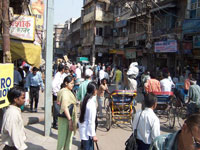
No trip to Delhi would be complete without a visit to one of the bazaars that surround Chandni Chowk (Moonlight Square) in Old Delhi, where shops and stalls display a wonderful array of goods, and offer a pungent and colourful insight into everyday Delhi life. Chandni Chowk has a large number of galis (lanes) and each one is different, with its own atmosphere and selection of goods to buy.Naya Bazaar, on Khari Baoli, is the spice market, displaying a wonderful range of seasonings in neat, colourful piles. The nearby Gadodia Market is the wholesale spice market. Hundreds of spices and condiments can be found there, including aniseed, ginger, pomegranate, saffron, lotus seeds, pickles and chutneys, to name just a few.Chor Bazaar sits behind the ramparts of the Red Fort and comes to life on Sundays to trade a collection of 'second-hand' goods. Chawri Bazaar was once notorious for the ladies who beckoned men from the arched windows and balconies above the street, but today these houses have made way for shops specialising in brass and copper Buddhas, Vishnus and Krishnas. Some of the busiest galis (east of Kalan Mahal) house the poultry and fish markets, but most tourists wisely avoid these areas.
Address : Chandni Chowk
Website : www.delhitourism.gov.in/delhitourism/shopping/chandni_chowk.jsp
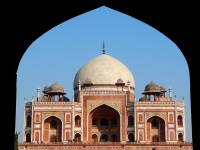
Humayun's Tomb is one of the best-preserved and most beautiful examples of Mogul architecture in Delhi, and is often seen as a forerunner of the Taj Mahal in Agra. Building started on the tomb in 1564 after the death of Humayun, the second Moghul emperor, and its construction was overseen by Haji Begum, his senior widow and the mother of Akbar. The tomb is an octagonal structure capped by a double dome that soars 125ft (38m) into the sky, and is set in a formal Persian garden. In the grounds are some other worthwhile monuments, including the Tomb of Isa Khan. Some careful restoration work has been done on some of the buildings and art but nothing important has been altered and the site has not lost its sense of authentic old age. Visiting this attraction is great for the uninitiated because it is the perfect introduction to the architecture, symbolism and importance of memorial tombs in India. For photography lovers the tomb, with its red colouring and geometric designs, is a wonderful subject. Tourist infrastructure is somewhat lacking, with only a few stalls, a tiny exhibit and no real public toilets - but, on the plus side, it is also less crowded and commercial than many other sites in the city and visitors can wander freely.
Address : Mathura Road
Website : www.humayunstomb.com/
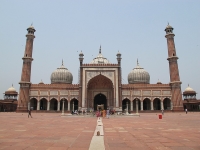
Shah Jehan, the architect of the Red Fort and much of Old Delhi, built Jama Masjid between 1644 and 1656. This grand structure is situated on a hill a few hundred yards west of the Red Fort, and towers over the mayhem of Old Delhi's sprawling streets. Jama Masjid is India's largest mosque, and can hold 25,000 worshippers at one time. Wide red sandstone steps lead to entrances on the north, south and east sides of the mosque. Inside is a massive courtyard, dominated by two red-and-white striped sandstone minarets that cap the main prayer hall on the west side (facing Mecca). There are smaller towers at each corner of the mosque, and energetic visitors can climb the 122 narrow steps of the southern one to be rewarded with magnificent views of Old and New Delhi.Those wearing shorts or skirts can hire a lunghito cover their legs. Women wearing T-shirts should bring a scarf to cover their shoulders. Visitors will be required to leave their shoes at the entrance. Tourists frequently complain that the people managing the mosque are rude and try to get as much money as possible out of visitors by charging for things like shoe storage and modesty dresses they insist women wear even if they are appropriately clad. The best way to deal with these inconveniences is to have a local guide to help navigate through the process.
Address : Matya Mahal, Bho Jala – a short walk west of the Red Fort
Website : www.delhitourism.gov.in/delhitourism/tourist_place/jama_masjid.jsp
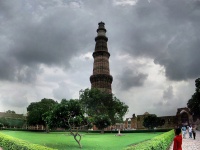
The Qutub Minar is a mammoth tower that was built between 1193 and 1369 to symbolise Islamic rule over Delhi, and to commemorate the victory by Qutab-ud-din over the city's last Hindu king. Standing 238 feet (72m) tall, the tower is decorated with calligraphy representing verses from the Quran, and tapers from 50 feet (15m) at the base to just eight feet (2.5m) at the top. There are five distinct storeys, each encircled with a balcony: the first three are built of red sandstone, and the upper two are faced with white marble.At the foot of the minhar stands Quwwat-ul-Islam, India's oldest mosque, largely built from the remains of 27 Hindu and Jain temples destroyed by the Muslim victors. The cloisters that flank the nearby courtyard are supported by pillars that were unmistakably pilfered from Hindu temples, but fascinatingly, the faces that would have adorned these pillars have been removed to conform to Islamic law, which strictly forbids iconic worship.Somewhat incongruously, in the corner of the mosque, stands the Iron Pillar, bearing 4th-century Sanskrit inscriptions of the Gupta period dedicating the structure to the memory of King Chandragupta II (373-413). It is said that anyone who can encircle the pillar with their hands whilst standing with their back to it will have their wishes fulfilled.
Address : Qutab Minar Complex, Mehrauli, nine miles (16km) from Connaught Place
Website : www.qutubminar.org/
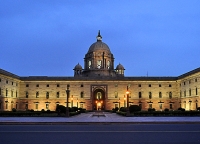
After his visit in 1911, the Emperor of India, King George V, decreed that the capital should be moved from Calcutta to Delhi. Edwin Lutyens was commissioned to plan the new government centre, which he focused around Rajpath - the grand, tree-lined boulevard that runs between the Secretariat Buildings and India Arch, the war memorial built in 1921. Rashtrapati Bhavan was built by Lutyens and Sir Herbert Baker between 1921 and 1929, on the gentle slope of Raisina Hill, flanked by the Secretariat Buildings. This immense palace, larger than Versailles, was created for the Viceroy and is now the residence of the President of India. With the exception of the central copper dome there are few concessions to Indian architectural style: despite its Classical columns, the building is unmistakably British and remains a potent symbol of imperial power.Every Saturday morning between 9:35am and 10:15am guards parade before the iron gates, in Delhi's answer to London's Changing of the Guard. The gardens are open to the public every year in February and March but unfortunately no entry to the palace is permitted at any time of year. However, the exterior is very impressive and it is well worth at least a drive by.
Address : Presidential Estate, North Avenue (formally Prakash Vir Shashtri Avenue), Rajpath
Website : www.rashtrapatisachivalaya.gov.in/
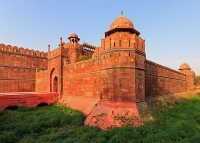
The Red Fort, known locally as Lal Quila, is Delhi's signature attraction, rising high above the clamour of Old Delhi as a reminder of the power and prosperity of the Mogul Empire. The massive sandstone walls were built in the 17th century to keep out marauding invaders, and still dominate the city's skyline today. Inside is an array of exquisite buildings, which once provided the living quarters for Shah Jehan, his courtiers, family and staff of three thousand. Visitors can marvel at the intricate decoration and only imagine the scenes here at the empire's height, when the walls were studded with precious stones and a 'stream of paradise' drove an ingenious air conditioning system. The fort was the scene of the Indian Uprising of 1857 and the mighty Lahore Gate, on the west side of the fort, remains a potent symbol of India's fight for independence. There are frequent sound and light shows in the evenings at the fort but they are conducted in Hindi; some audio guides are sometimes available to translate into French and English. The fort is vast and there is a lot to explore so it is best to allow a few hours for this famous attraction; seeing everything means covering quite a lot of ground so come prepared to do some walking.
Address : On Netaji Subhash Marg, near Chandni Chowk in Old Delhi. Entrance from Lahore Gate or Chatta Chowk
Website : www.whc.unesco.org/en/list/231

Travel Guide powered by Word Travels, copyright © 2023 Globe Media Ltd. By its very nature information in this travel guide is subject to change at short notice and travellers are urged to verify information on which they're relying with the relevant authorities. Neither Globe Media Ltd nor Travel Vogue can accept any responsibility for any loss or inconvenience to any person as a result of information contained above.